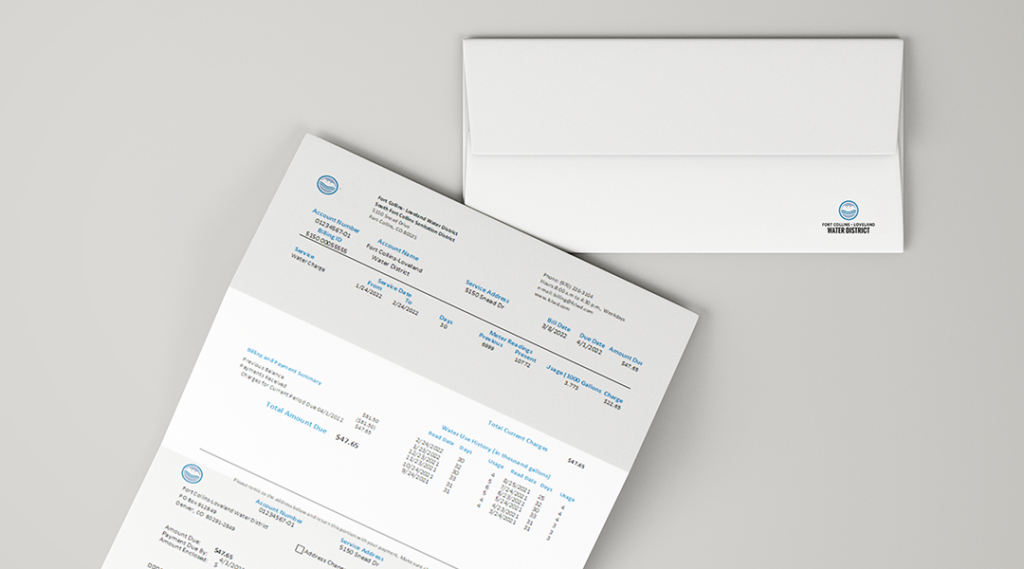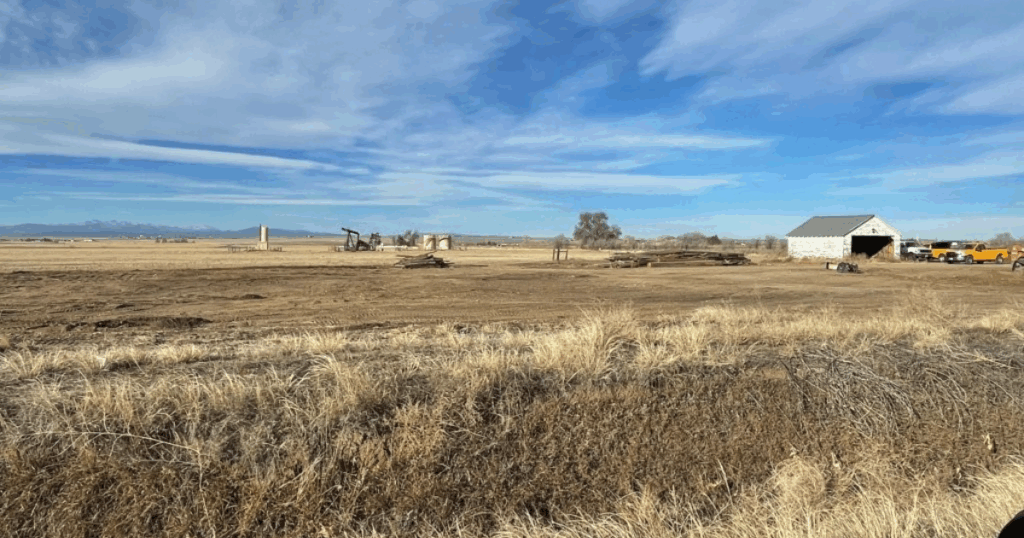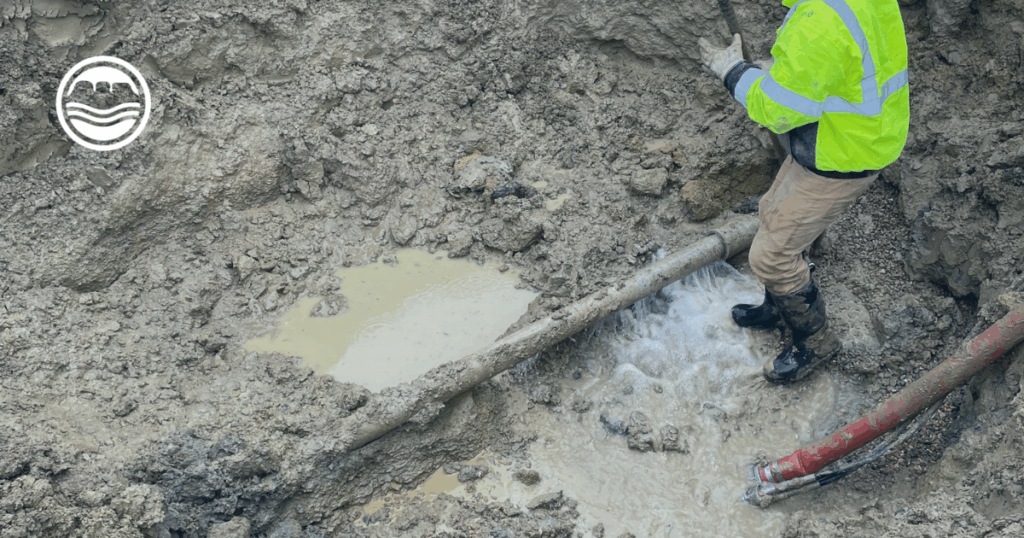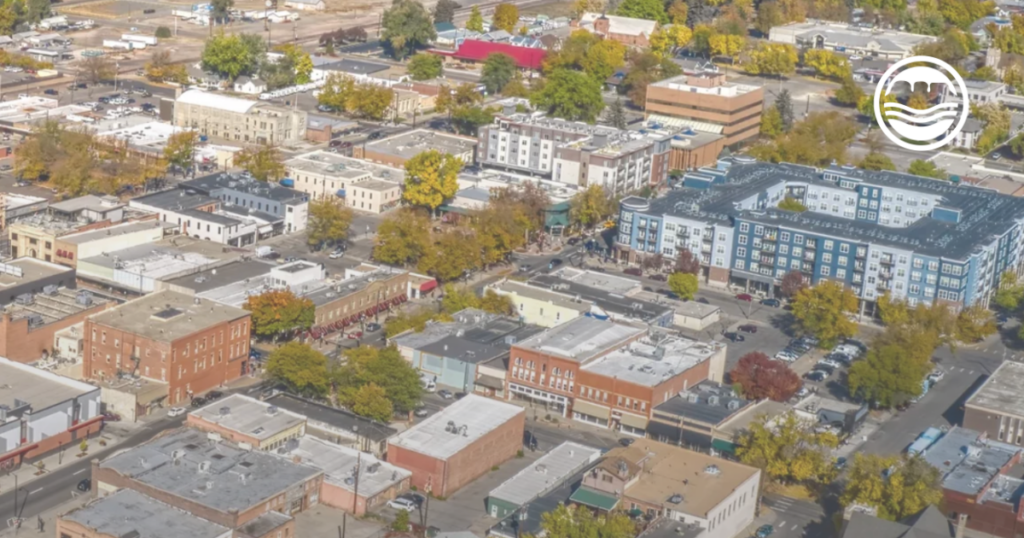This blog is the first installment of our District Funding series, where we examine the ways the Fort Collins-Loveland Water District is funded through various initiatives and fees. This particular post covers monthly bills for current customers. To read the next in the series, which covers developers and new tabs click here.
Bills. You get them every month, but how well do you really know your monthly bill? For many, a quick glance at the Total Due suffices, but there’s so much more to discover in your paper or digital statement. From statement comparisons to rate breakdowns, a bill from the Fort Collins-Loveland Water District provides insight into how you engage with your water supply. It can even provide evidence of unknown leaks or other issues should you detect a spike in usage that’s inconsistent with your habits. To help you better understand your monthly bill—and maybe even stoke a bit of curiosity—we’re breaking down what your statement means, and how those funds apply to District initiatives.
How To Read Your Monthly Bill
At first glance, monthly bills can appear hard to decipher, but if you examine them a little bit more closely, all becomes pretty clear. Check out the marked-up bill above, and then review the terms below
for an even better understanding of your monthly statement.
- Billing ID: This is the number specifically used for your online account. Don’t have an online account yet? You can visit the online Pay My Bill site to setup and access your account.
- Service Date From/To: This is the range of dates covered in your current bill.
- Read Date: This is the date your meter was read by our team.
- Usage (1000 gallons): This is the exact meter reading of your water usage between Service Dates.
- Usage: This is your meter reading, rounded to the nearest thousand
- Charge: This is your total charge based on your exact meter reading.
For most people, the most important component of a bill is the charge. You might wonder how your charge is calculated each month. When it comes to water, we utilize a cost-of-service model at FCLWD, meaning you only pay for the water you actually use each month. Your monthly charge is calculated using two components: a base fee and a water consumption charge.
The average household pays a base fee of $15.75 per month. From there, customers are charged based on how much water they used. Water usage charges are broken into three tiers, meaning customers who use more water pay more each month and customers who use less pay less. Rates also depend on where you live within our District. If you’re within the “City of Fort Collins Service Area” you’ll pay a different rate than if you’re not within the service area. There are lots of numbers to analyze so you recommend referencing the back of the bill to really dive into the details. If you have questions about your charges, you can always reach out to our team and we can walk you through it.
How Does Your Monthly Payment Fund the FCLWD ?
Now that you have a better understanding of how to decipher your bill, your next question might be: “What does the District actually do with my payment each month?” Great question! As you know, the District maintains a “Growth to Pay Its Way” approach to new developments, which factors heavily into how your payment as a current customer is tagged for funding.
For current customers, payments are earmarked specifically to cover the cost of service for water delivery. Within the District, we categorize these as “Operational Projects”, and they support our collective mission to deliver clean, refreshing water to each customer.
However, Operational Project expenses encompass more than the delivery of water. There are built-in costs including the replacement of aging infrastructure, updates to the current water treatment plantss and other expenses that keep operations moving swiftly and efficiently.
FCLWD has done extensive rate studies to ensure our rate structure is fair to customers but also that we can cover expenses to fulfill our mission of providing high-quality, secure, reliable and affordable water. That said, monthly rates are subject to change with the cost of operations. As costs of fuel and other necessities rise, it will be reflected in monthly bills. In order to ensure customers continue to have excellent water quality, we sometimes need to adjust our operating revenue which also means rate adjustments. Because we are dedicated to providing affordable water, raising rates is not a matter we take lightly. Our board of directors conduct extensive research and planning to ensure they are making the right decision for the future of the District.
But what about new projects centered around keeping up with growth? Those are categorized as “Non-Operational Projects”, and monthly service bills, meaning current customers, do not fund those projects. These projects actively build the holdings of the FCLWD in a strategic effort to keep pace with the region’s growth. We don’t believe it’s fair for current customers to pay for new growth, which is why we raise funding for Non-Operational Projects through tap fees from new customers. This is the essence of our “Growth to Pay Its Way” approach. Projects in this bucket include new water treatment plants or new raw water purchases —emphasis on new.
Of course, not everything is so cut-and-dry that we can easily categorize funding into one of two categories. Projects or initiatives that fall into a gray area are split-funded, which means a portion of payments from current customers is applied. This might look like a project where we need to replace an old pipe to ensure we can continue delivering water to current customers, but when we replace that pipe, we’re going to replace it with a larger pipe to accommodate future demand. How does this funding for this project work?
Split-funding allows us to assess what percentage of a project would service current customers vs. new customers and charge accordingly. If 60% of a project benefits current customers, then 60% of the funding comes from monthly service charges, with the other 40% from new tap fees. Not only is this approach fair, but it also ensures every aspect of a project is necessary and accounted for.
Smart planning paves the way for a successful District
By better understanding how to read your bill, and how your monthly payment is earmarked for funding, we hope you’re encouraged to become more actively involved in the FCLWD—even if that means simply reading your bill every month. One of the immediate benefits of monitoring your monthly bill is catching abnormal spikes in usage. Usage spikes are often a sign of leaks in your pipes or appliances, so catching them early is important.
Water usage, cost and conservation are important topics, especially in the case of the FCLWD, which will inevitably grow along with the region. Stay tuned to this blog for more on how the District funds new initiatives through development and tap fees and how we’re planning for the future.
 Skip to content
Skip to content








